Seapost -> Cunard
Cunard
By Julian H Jones
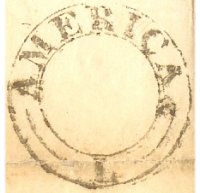
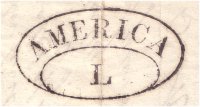 The British Admiralty, which awarded packet contracts at the time, signed a seven year
contract with the British and North American Royal Mail Steam Packet Company to carry mail to
North America commencing 1st July 1840. The line was known after the Nova Scotia ship owner
Samuel Cunard and
'Britannia'
sailed from Liverpool on 4th July. The cost of a half ounce letter
from Britain to the USA was set at one shilling
(the equivalent of 24 US cents). Distinctive packet marks were introduced at Liverpool to handle
the new mail service.
The British Admiralty, which awarded packet contracts at the time, signed a seven year
contract with the British and North American Royal Mail Steam Packet Company to carry mail to
North America commencing 1st July 1840. The line was known after the Nova Scotia ship owner
Samuel Cunard and
'Britannia'
sailed from Liverpool on 4th July. The cost of a half ounce letter
from Britain to the USA was set at one shilling
(the equivalent of 24 US cents). Distinctive packet marks were introduced at Liverpool to handle
the new mail service.
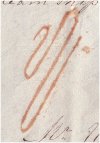 Initially the ships ran between Liverpool and Boston, calling at Halifax, Nova Scotia, in each
direction. In 1846 the contract was extended until 1858 with the addition of New York as
the alternate western terminus from January 1848. The service was successful in carrying a
large amount of American mail destined for Great Britain and Europe on a regular, frequent
basis. Some interesting rate hand stamps appeared to replace hand-written markings.
Initially the ships ran between Liverpool and Boston, calling at Halifax, Nova Scotia, in each
direction. In 1846 the contract was extended until 1858 with the addition of New York as
the alternate western terminus from January 1848. The service was successful in carrying a
large amount of American mail destined for Great Britain and Europe on a regular, frequent
basis. Some interesting rate hand stamps appeared to replace hand-written markings.
The success of Cunard provoked the US Government to tender for a competing service which was won by the Ocean Steam Navigation Company operating from New York to Bremerhaven with a call off Cowes, Isle of Wight, in each direction. The maiden voyage was in June 1847 and mails processed at Southampton were charged as if they had been carried by Cunard, causing retaliatory action by Congress at what they saw as a British discriminatory tax on mail. This was finally resolved by the Anglo-US postal Treaty of 1848, which came into force in February 1849. By 1857 the Ocean Line was in decline and the US contract terminated, but by then the successful American-owned Collins Line was competing with Cunard for passengers and mail on the New York to Liverpool route.
By the winter of 1851-52 Cunard Line was able to run weekly sailings year round including the winter months. Cunard again successfully negotiated a new contract to run from June 1858 to January 1868. In November 1859 Cunard commenced calls at Queenstown (Cobh), Ireland on both inbound and outbound voyages. On inbound voyages mail (except that for Liverpool and Scotland) was offloaded at Queenstown and sent by train to Dublin, from where London bagged mail left via Kingstown by steamer (the H & K Packet) for Holyhead. From there it went directly by rail to London. On the outbound journey mail posted in London on the same day as the Liverpool sailing was collected at Queenstown together with outbound mail from Ireland. In later years these services became the 'DUBLIN & CORK TPO / AMERICAN MAIL', or the 'Dublin & Queenstown T.P.O' and the 'London & Holyhead TPO (United States Mail)', or their derivatives.
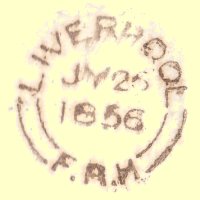 It was also possible to post letters up to ten minutes before departure of the ship at the
Liverpool quayside. For the payment of a 1/- fee, letters could be presented at the
Floating Receiving House, where they received a distinctive cancel.
It was also possible to post letters up to ten minutes before departure of the ship at the
Liverpool quayside. For the payment of a 1/- fee, letters could be presented at the
Floating Receiving House, where they received a distinctive cancel.
 Sorting officers had been carried on eastbound voyages since 1860 to speed up the sorting
and bagging of mail. These were withdrawn in 1869 when the contract with the British Post
Office was again renewed. Special cancellers had been issued in 1859 to cancel letters sorted on board.
Sorting officers had been carried on eastbound voyages since 1860 to speed up the sorting
and bagging of mail. These were withdrawn in 1869 when the contract with the British Post
Office was again renewed. Special cancellers had been issued in 1859 to cancel letters sorted on board.
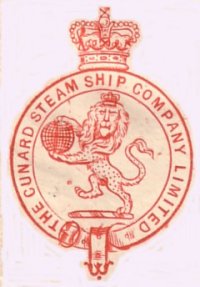 By the 1870's Cunard Line was competing with a plethora of steamship lines carrying mail
across the North Atlantic, including: Allan; Inman; HAPAG, North German Lloyd; and White Star.
By 1875, with the advent of the UPU, postal rates had fallen to 2½p per ½ oz and there were no
longer postal markings to differentiate which line carried the vast quantities of surface mail
across the oceans. Although Cunard continued to carry mail up to and after WW I it did not
participate in the joint US Seapost operations of White Star Line, United States Line,
French Line, Hamburg America Line and North German Line.
By the 1870's Cunard Line was competing with a plethora of steamship lines carrying mail
across the North Atlantic, including: Allan; Inman; HAPAG, North German Lloyd; and White Star.
By 1875, with the advent of the UPU, postal rates had fallen to 2½p per ½ oz and there were no
longer postal markings to differentiate which line carried the vast quantities of surface mail
across the oceans. Although Cunard continued to carry mail up to and after WW I it did not
participate in the joint US Seapost operations of White Star Line, United States Line,
French Line, Hamburg America Line and North German Line.
References
The Transatlantic Mail, Frank Staff, 1980 edition, Quarterman Publications, Inc., Lawrence Mass
History of Letter Post Communications Between the United States and Europe 1845-1875, by G E Hargest
North Atlantic Mail sailings 1840-75, W Hubbard and R F Winter,
US Philatelic Classics Society, Inc., 1988
Understanding Transatlantic Mail, Vol 1, by R F Winter,
American Philatelic Society
The Travelling Post Offices of Great Britain & Ireland, Harold S Wilson, 1996
The Irish Mail, by Cyril Kidd,
The TPO and Seapost Society, (2nd Edition) 1996
United Kingdom Letter Rates, Inland and Overseas, 1635 to 1900, Colin Tabeart, Second Edition 2003,
HH Sales Limited, Bradford
Robertson Revisited, Colin Tabeart, 1997 edition,
James Bendon Ltd, Limassol, Cyprus

